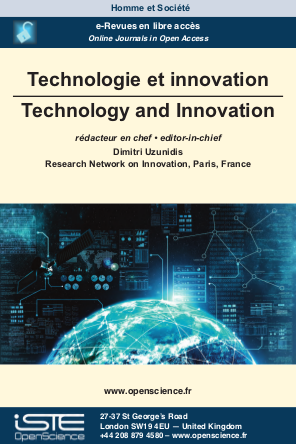

Social Sciences and Humanities > Home > Technology and Innovation > Issue
This paper is an introduction to the special issue "Artificial Intelligence and Quantum Technologies in relation to Cybersecurity" from the journal "Technology and Innovation". It proposes a development of the themes at the heart of this issue, a contextualization of the related elements, as well as a rundown of all the articles constituting the special issue.
Digital transformation is accelerating the development of artificial intelligence, which in turn is accelerating digital transformation, thus irreversibly permeating society. The integration of artificial intelligence in the functioning of companies and its use throughout all societal life raises the question of the probable associated risks. This article presents the advent of artificial intelligence and analyzes several risks related to incremental and disruptive innovation with regards to societal life. It discusses the advantages and areas that must be taken into account concerning this digital transition.
Imaginary representations of hackers in science fiction have evolved since the 1960s. Cyberpunks have helped popularize the image of a rebellious, often anarchical, individual, who wields considerable technological power. In this article, a panorama of the most famous works featuring hackers is drawn up. Neuromancer, Snow Crash, Sword Art Online, The Matrix or Salvation are the most notable. The hacker character can either be a hero defending libertarian values, or a dangerous terrorist harmful to the human race. These representations have, in turn, had an influence on representations of cybercrime. They have influenced vocations among future computer scientists, as well as inspired the research of cybersecurity specialists. At the economic level, hackerspaces are based on a philosophy inspired by the digital anarchism of cyberpunks.
Over the course of this decade, an unprecedented phenomenon has marked monetary history and will undoubtedly affect the future of payment systems. We speak of course of virtual currencies whose exchange platforms are disintermediated and unregulated, juxtaposing current payment systems. Their advent took monetary authorities from around the world by surprise and have raised fundamental questions on: the future trajectory of conventional currencies, the relevance of the role of central banks and the fate of financial stability. These issues are legitimate in a context of uncertainty caused by this irreversible movement of technological and financial innovations from private groups. Major events await regulatory authorities. Should they admit the risks and possible impacts that may be generated by decentralized and unregulated payment systems, or should they continue to harden their position regarding these private virtual currencies?
The MIL-STD-1553B is a standard defining a set of requirements which cover all aspects of a serial multiplex data bus, from mechanical to electrical and functional aspects. The bus aimed to interconnect avionics subsystems via a single medium. Several military services and contractors adopted MIL-STD-1553 as an avionics data bus due to its data integrity insurance. However, new research work has demonstrated a set of security vulnerabilities for this bus. This paper presents the creation of effective intrusion detection systems (IDS) for avionics networks and bus technologies used within the aerospace and space industry.
This article analyzes the principles of data minimization and of necessity outlined in the General Data Protection Regulation (GDPR) in Europe and in Bill 25 in Quebec. It draws respectively on the Commission nationale informatique et libertés (CNIL), the French gendarme of personal data, and the Commission d’accès à l’information (CAI), the overseeing body in Quebec for the application of the Access Act and the Privacy Act. This article demonstrates how the principle of necessity can lead to responsible innovation.
The graphic novel Invisible Force reflects on the influence of artificial intelligence as well as the manipulation of information on social networks in future conflicts. Combining fiction with the opinions of experts, this institutional science fiction aims to carry out a useful forecast for decision-makers, as well as to communicate a strategic vision to soldiers. It also aims to make the general public aware of the geostrategic issues of tomorrow; this use of science fiction for military propaganda purposes is becoming increasingly widespread. The English-speaking world has used it for a long time, and this practice has also been adopted in France. We see this in, for example, the fact that the French army recruited science fiction authors to imagine the wars of the future through the Red Team.
This paper analyzes the multiple facets related to the advancement of quantum technologies. To this end, the quantum mechanics necessary for the development of these technologies are first explained from a didactic perspective. Then, investments related to the progress of quantum technologies are shown, in an exhaustive way regarding the French quantum plan, and following elements of comparison concerning the main international plans and developments specific to digital giants. An overview is drawn up, including drivers of material and social progress related to quantum technologies. The potential risks and dangers are also explained, with a particular focus on the cybersecurity aspects of quantum technologies. Thus, guidelines and indicators are developed so that one can better understand the quantum revolution that is taking place and that will, in the near future, be at the root of colossal steps, vectors of gigantic progress, following on from Promethean quantum power.

2025
Volume 25- 10
Issue 12024
Volume 24- 9
Issue 12023
Volume 23- 8
Issue 12022
Volume 22- 7
Issue 12021
Volume 21- 6
Issue 12020
Volume 20- 5
Issue 12019
Volume 19- 4
L’innovation agile2018
Volume 18- 3
Issue 42017
Volume 17- 2
Mobility Innovations. Transport, management of flows and territories2016
Volume 16- 1
Issue 1